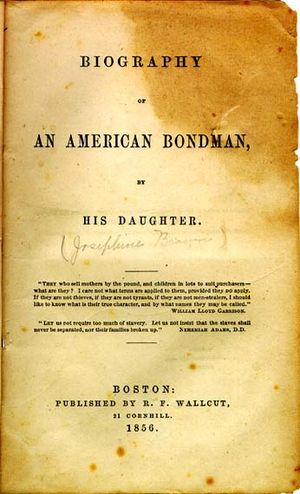Josephine Brown facts for kids
Quick facts for kids
Josephine Brown
|
|
|---|---|
| Born |
Elizabeth Josephine Brown
June 12, 1839 |
| Died | January 16, 1874 |
| Occupation | Teacher, Anti-slavery lecturer, Biographer |
| Movement | Colored Conventions Movement |
| Spouse(s) | George S. Dogans, James (?) Campbell |
| Parent(s) | William Wells Brown, Elizabeth Schooner |
Elizabeth Josephine Brown (born June 12, 1839 – died January 16, 1874) was an American teacher, writer, and activist. She was the daughter of William Wells Brown, who had escaped slavery. Josephine wrote a book about her father's life called Biography of an American Bondman, by His Daughter, published in 1856.
For a long time, people thought her book was the first biography written by an African-American woman. However, it was later discovered that Susan Paul had written an earlier one in 1835. Josephine's book shared many details from her father's own story, Narrative of William W. Brown, A Fugitive Slave (1847). But Josephine also included more details about the harsh treatment enslaved people faced. She also wrote about the challenges faced by enslaved people of mixed African and European heritage. Her book also covered her father's time living in Europe.
Josephine's Early Life
Josephine's father, William Wells Brown, was born into slavery in 1814. He was one of seven children born to his enslaved mother, Elizabeth. In 1834, William escaped to freedom in the North and settled in Cleveland, Ohio. There, he married Elizabeth Schooner, who was of mixed African-American and Native American background.
The Browns had two daughters while living in Cleveland. Their first daughter, born in 1835, sadly died as a baby. Their second daughter, Clarissa, was born in 1836. The family then moved to Buffalo, New York. Josephine, their third daughter, was born in 1839. She later stated she was born in Detroit, Michigan. Another daughter, Henrietta Helen, was born in 1842 but died young in 1844.
In 1845, the Brown family moved to Farmington, New York. William Wells Brown and Elizabeth Schooner separated in 1847. William took care of his daughters and moved to Boston. While he traveled as a speaker against slavery, Clarissa and Josephine attended a boarding school. They lived in New Bedford, Massachusetts, and were taught by Nathan Johnson, a well-known abolitionist.
Education and Travel in Europe
In 1849, William Wells Brown was invited to a special meeting in Paris, France, called the International Peace Congress. He went there to speak out against slavery. After the Fugitive Slave Act of 1850 was passed in the United States, which made it easier to capture escaped slaves, William decided to stay in Europe. He continued to give speeches and write.
In 1851, Clarissa and Josephine joined their father in London for a short time. They then went to a boarding school in Calais, France. In 1852, the girls returned to London. They trained at the Home and Colonial School to become teachers or governesses. During this time, Josephine sometimes helped her father with his work against slavery. She joined him on his speaking tours and helped write down his letters. In December 1853, Josephine passed her final exams. She then became a school mistress at the East Plumstead School in Woolwich, England.
Josephine's mother died in Buffalo in 1852. In 1854, supporters of the anti-slavery movement bought William Wells Brown's freedom from his former owner. He then returned to the United States. His daughters, Clarissa and Josephine, remained in England.
Activism and Writing
In 1855, Josephine decided to return to America. She traveled across the ocean with Horace Greeley, a famous abolitionist. She joined her father in Boston and worked with him for a while. They both gave speeches against slavery in New England.
Josephine's father's earlier autobiography was no longer being printed. So, Josephine decided to publish Biography of an American Bondman in 1856 to make sure his story was still available. She had started writing the book while she was at school in France. Her biography used information from her father's 1847 autobiography. But she added more details about the abuses he suffered as an enslaved person. She also wrote about the difficulties faced by enslaved people of mixed heritage from both Black and white people. Josephine also described her father's travels in Great Britain.
Later Life
It is believed that Josephine Brown returned to England in 1856. She continued her career as a teacher there.
Josephine Brown Campbell, as she was known after marriage, passed away in 1874. She died from tuberculosis and was buried in Cambridge Cemetery in Cambridge, Massachusetts.


